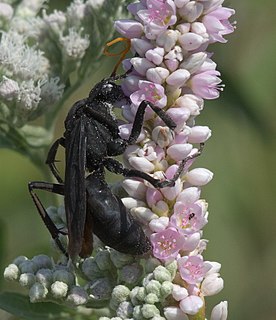
Kiwi are flightless birds endemic to New Zealand of the genus Apteryx and family Apterygidae. Approximately the size of a domestic chicken, kiwi are by far the smallest living ratites.

Nightjars are medium-sized nocturnal or crepuscular birds in the family Caprimulgidae and order Caprimulgiformes, characterised by long wings, short legs, and very short bills. They are sometimes called goatsuckers, due to the ancient folk tale that they sucked the milk from goats, or bugeaters, their primary source of food being insects. Some New World species are called nighthawks. The English word "nightjar" originally referred to the European nightjar.

The turkey is a large bird in the genus Meleagris, native to North America. There are two extant turkey species: the wild turkey of eastern and central North America and the ocellated turkey of the Yucatán Peninsula in Mexico. Males of both turkey species have a distinctive fleshy wattle, called a snood, that hangs from the top of the beak. They are among the largest birds in their ranges. As with many large ground-feeding birds, the male is bigger and much more colorful than the female.

Aster is a genus of perennial flowering plants in the family Asteraceae. Its circumscription has been narrowed, and it now encompasses around 170 species, all but one of which are restricted to Eurasia; many species formerly in Aster are now in other genera of the tribe Astereae. Aster amellus is the type species of the genus and the family Asteraceae.

Sir David Frederick Attenborough is an English broadcaster, natural historian and author. He is best known for writing and presenting, in conjunction with the BBC Natural History Unit, the nine natural history documentary series forming the Life collection that constitute a comprehensive survey of animal and plant life on Earth.

Echinacea is a genus of herbaceous flowering plants in the daisy family. It has ten species, which are commonly called coneflowers. They are found only in eastern and central North America, where they grow in moist to dry prairies and open wooded areas. They have large, showy heads of composite flowers, blooming in summer. The generic name is derived from the Greek word ἐχῖνος, meaning "sea urchin", due to the spiny central disk. These flowering plants and their parts have different uses. Some species are cultivated in gardens for their showy flowers. Two of the species, E. tennesseensis and E. laevigata, are listed in the United States as endangered species.

Cardinals, in the family Cardinalidae, are passerine birds found in North and South America, Central America, and the Caribbean. They are also known as cardinal-grosbeaks and cardinal-buntings.

Phoneutria is a genus of spiders in the family Ctenidae of potential medical significance to humans. They are mainly found in northern South America, with one species in Central America. Members of the genus are commonly referred to as Brazilian wandering spiders. Other English names include armed spiders and banana spiders.

An argus, or argus pheasant, is a member of the subtribe Argusianina in the tribe Pavonini of the family Phasianidae, containing two species of bird that are closely related to peafowl. It has hundreds or thousands of tiny white spots on its plumage pattern, and thus its naming might have been in reference to the mythical hundred-eyed giant, Argus Panoptes.

Acer is a genus of trees and shrubs commonly known as maples. The genus is placed in the family Sapindaceae. There are approximately 132 species, most of which are native to Asia, with a number also appearing in Europe, northern Africa, and North America. Only one species, Acer laurinum, extends to the Southern Hemisphere. The type species of the genus is the sycamore maple, Acer pseudoplatanus, the most common maple species in Europe. The maples usually have easily recognizable palmate leaves and distinctive winged fruits. The closest relatives of the maples are the horse chestnuts. Maple syrup is made from the sap of some maple species.

Austromuellera is a genus of only two known species of medium-sized trees, constituting part of the plant family Proteaceae. They are both endemic to three restricted areas of the wet tropics rainforests of north-eastern Queensland, Australia. The genus was named in 1930 in honour of Ferdinand von Mueller by Cyril T. White. They lie within the tribe Banksieae within the family Proteaceae, their closest relatives the genera Musgravea and Banksia.
Tectiphiala ferox, or palmiste bouglé, is a species of flowering plant in the family Arecaceae. It is endemic to Mauritius.

Picramniaceae is a small, mainly neotropical family of four genera Aenigmanu, Alvaradoa, Nothotalisia and Picramnia. The family is the only member of the order Picramniales. Members of the family were formerly placed in the family Simaroubaceae or misidentified as species in the family Sapindaceae, in the order Sapindales. The most recent standard classification of the Angiosperms distinguishes it as a separate family and order. It belongs to the malvids, one of the three groups that constitute the rosids. As of 2016, Picramniaceae included three genera with 49 known species.

Ampullaviridae is a family of viruses that infect archaea of the genus Acidianus. Only one genus in this family has been described, Bottigliavirus, which contains three species. The name of the family and genus is derived from the Latin word for bottle, ampulla, due to the virions having the shape of a bottle. The family was first described during an investigation of the microbial flora of hot springs in Italy.
Hukuchivirus is a genus of double-stranded DNA viruses that infect thermophilic bacteria. The genus was previously named Gammasphaerolipovirus.

Heterocyathus is a genus of coral of the family Caryophylliidae.
Kataigidodon is an extinct genus of eucynodont cynodont therapsid that was discovered in the Chinle Formation of Arizona. It is a monotypic genus, with only type species Kataigidodon venetus known.

Entypus fulvicornis is a species of spider wasp belonging to the family Pompilidae. It is found in North America.
Ceafornotensis is an extinct genus of beetles in the superfamily Scarabaeoidea, with only one member, Ceafornotensis archratiras. It is currently extinct globally.














